Helping the cause of macaws
Scientists' discoveries about macaws may help these magnificent birds survive.
Deep in the steamy Peruvian jungle, a macaw spreads her brilliant scarlet feathers over her three squirming chicks. She pokes her great beak out the door of the wooden box where she has made her nest and waits for her mate to return with food.
Fifty feet below, Jerome Hillaire and Karina Quinteros of the Tambopata Research Center look up from a laptop to admire the bird as she cocks her head at them. The computer’s screen is showing live images of the macaw and her chicks, sent from a tiny camera that the researchers have tucked inside her nest. They hope that understanding how macaws live will help efforts to save the birds.
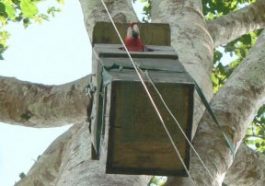 |
|
Macaws normally nest in cavities in very large, old trees. At Tambopata, researchers hang artificial nests from big trees for the birds to use.
|
| David Hauer |
Parrots in peril
Like many other kinds of parrots in the wild, macaws are in trouble. People sometimes kill them for their beautiful feathers, or capture the chicks and sell them as pets.
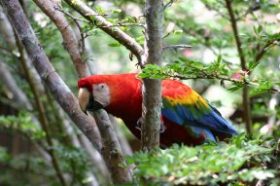 |
|
Many parrots, such as this macaw, are endangered.
|
| © Donald Brightsmith, Texas A&M University |
More important, the macaws are losing their homes. These birds usually nest in natural cavities in old trees. These large trees are valuable for lumber, so they’re often cut down, and the macaws are left with nowhere to lay their eggs.
Fake nests
So, researchers at Tambopata built artificial nests out of wood or pieces of plastic pipe. They hung the nests from trees and then watched to see whether the macaws would use them.
The scientists were pleased to see that the birds seem to approve of the fake nests. The macaws used them year after year. Since that discovery, people have begun building similar artificial nests in other areas where macaws are struggling to survive.
In addition to helping the birds, the fake nests make life easier for the researchers. They now have lots of subjects to observe near Tambopata. The squawking sounds of macaws fill the air around the research center.
“It’s a parrot laboratory, because there are lots of birds,” says Donald Brightsmith, Tambopata’s research director. “It’s a very good place to learn how parrots work.”
Learning more about macaws
Hillaire and Quinteros, for example, are trying to solve a puzzle about macaw chicks. Macaws often lay three or four eggs at a time, but only one or two of the hatchlings develop to maturity. The other chicks starve during infancy, even if the parents have plenty of food.
Hillaire and Quinteros want to know why.
They note how much time the mother macaw spends with her chicks, how often she feeds them, how often the chicks fight with each other, and how much food each chick gets.
“The third chick is going to die soon,” Hillaire says, as he studies another live image on the computer screen. The first-born chick fills most of the screen, but off in the corner, a scrawny chick trembles. “It’s kind of sad. You watch him day after day, and he fights and fights and fights, and he only gets a little food. He’s wearing himself out with all that fighting.”
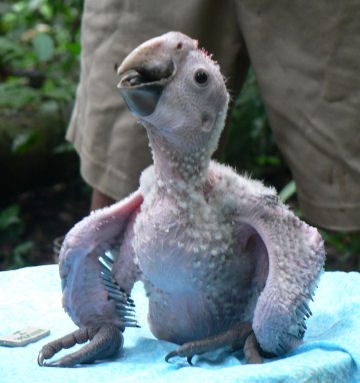 |
|
This macaw chick is about a month old. The researchers climbed up the tree and removed him from his nest in order to weigh him. His parents swooped down to attack the researchers while they did that!
|
| David Hauer |
Cheeky chicos
Early in the research center’s history, scientists decided to try to save the third and fourth eggs and raise the chicks by hand. (The researchers call the young birds “chicos,” which means “kids” in Spanish.) Of the eggs they saved, 26 chicos grew into adult macaws. The birds now live free in the jungle. They’ve found mates, and most have raised chicks of their own.
But because the birds got used to humans, many like to come back and visit. They’ll fly into the center’s open-air dining room, march across the tables, and snatch food from people’s plates. They can be lured with food to stand on someone’s shoulder. They’ll also steal shiny things such as watches or jewelry.
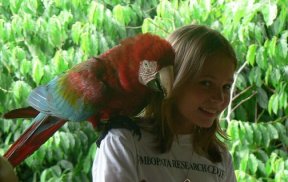 |
|
Researchers hand-raised some of the chicks that wouldn’t have survived in their parents’ nests. These birds now live in the jungle, but like to come back for treats.
|
| David Hauer |
The researchers stopped hand-raising chicks from the third and fourth eggs a dozen years ago. They didn’t think it was a good idea to create partly tame parrots. What’s more, the macaw population in the area was thriving, even though some chicks were not surviving.
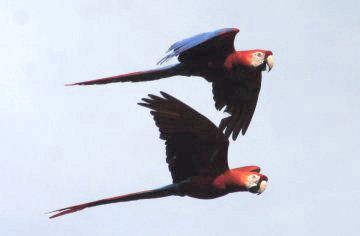 |
|
Macaws, which ordinarily mate for life, are often seen flying in pairs.
|
| © Donald Brightsmith, Texas A&M University |
Tasty clay
Bird researchers like Tambopata because the area has so many macaws. The birds have a different reason for liking the place. Tambopata has an enormous clay lick, which is a place with a special kind of clay-rich dirt that the birds like to eat. This clay lick, which forms a 1,500-foot-long cliff, is the largest one known in the world.
The researchers get up at 4 a.m. every day. They arrive at the clay lick before dawn to count how many birds show up. The smaller parrots, such as mealy parrots, are usually the first to fly around the lick, gabbling in high voices. Then other birds—blue-headed parrots, chestnut-fronted macaws, dusky-headed parakeets—join in. Eventually, a pair of great scarlet macaws will soar overhead, slowly flapping their enormous wings.
Finally, the birds pick a spot to land. They start scooping up dirt with their beaks. The birds use the clay lick most heavily during the breeding season. They feed clay to their chicks too.
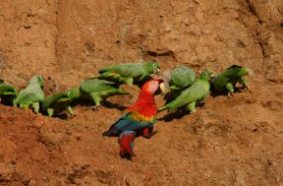 |
|
Macaws and other parrots in Tambopata like to eat dirt. The dirt contains special, salty clay that may help the birds get rid of toxins in their diets.
|
| © Donald Brightsmith, Texas A&M University |
The researchers think that the birds eat the clay because it contains salt, which the birds need in their diets. They also think the clay protects the birds against toxins in the seeds and fruit they eat. And the birds seem to enjoy eating the clay. It probably tastes good to them, says Brightsmith.
Helping all parrots
The knowledge gathered at Tambopata is helping parrots around the world.
The artificial nests that the researchers have developed are being used to save macaws in immediate danger of extinction. These endangered birds include the great green macaw, which lives in Ecuador and Costa Rica. Brightsmith is working with the Brazilian government to develop a plan to protect Brazil’s wild macaws. And what Tambopata researchers have learned about the diets of wild parrots is even helping improve commercial bird foods such as those you might feed a pet parrot.
Brightsmith hopes that the center’s work will help ensure that macaws continue to flash scarlet streaks through the Amazon jungle for centuries to come.
Going Deeper:







